Engravings of the year 1631

Several dishes are on view, followed by Saxon sweets.
Tilly, with three of his generals, is sitting at a table with several bowls. He is being approached by a Swedish lion holding a map, representing the Battle of Leipzig, and by Gustav Adolf of Sweden with two platters containing Mainz and Würzburg; he is followed by John George of Saxony with Prague and the Landgrave of Hessen carrying Fulda. General Gustav Horn, carrying Bamberg in a bowl, is last. In the background, the Battle of Leipzig is illustrated. Beneath the picture there is an extensive German poem explaining the illustrated scene.
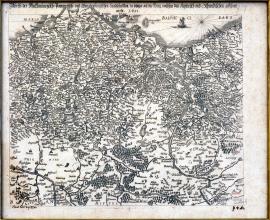
A map of the territories of Mecklenburg, Pomerania and Brandenburg, where at present a war is being waged between Imperial forces and the Swedes – 1631.
This is a map of the territories of Mecklenburg, Pomerania and Brandenburg. The Oder flows on the right-hand side; at the bottom on the left there is a small stretch of the river Elbe. In the north are the mapped territories bordered by the sea (“Maris Balthici Pars“), on which a ship is sailing. The entire area of the print is filled with geographical signs.
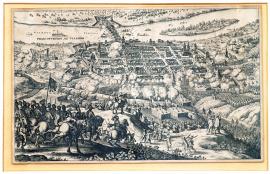
Frankfurt-on-Oder
Here we see a view of the city conquered on the 3rd (13th) of April 1631 by the Swedes. In the background we can see the flow of the Oder with a large bridge and island, across which Imperial forces are fleeing. On the other bank there are many men on the run. The city is under strong Swedish artillery fire. In the left foreground there is an artillery division with the trumpeter and standard-bearer's horse rearing up. On a nearby hillock, there are two more trumpeters. The usual explanatory text is missing here.
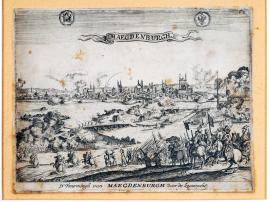
Magdeburg. The conquest of Magdeburg by Imperial forces.
This is a small picture of the city of Magdeburg, besieged by Imperial troops. In the foreground there is a military scene with horsemen and banners. The troops are advancing across a bridge over the Elbe. In the background, the city is shrouded in smoke and flames. The quoted Dutch inscription is located on an uncoiled banner in the sky; beside it is the city emblem and an Imperial eagle with a laurel branch around it. The etching is a remarkable, extraordinarily beautiful and delicately made work of art, but it is virtually unknown. Even its great author is unknown.
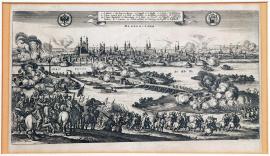
Magdeburg
The print depicts the conquest of Magdeburg by Tilly in 1631. The high artistic level of the engraving and the distinctive character of the composition bears witness to Merian's authorship, although the print has not been signed. In the middle of the picture is the river Elbe, spanned by a bridge across which troops are advancing. The burning city is in the background, and in the foreground there is a cavalry division. On the uncoiled banner in the sky, there is the legend 1-25, and on the sides there are the city and Imperial coats of arms.
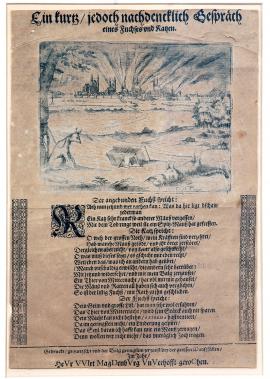
A short but witty conversation between the fox and the cat. Printed, pressed and fur sufficiently ruffled at the big mousetrap that year: this year, Magdeburg will be avenged.
The German poem under the picture contains a dialogue between the fox (Gustav Adolf) and the cat (Tilly). The overturned mousetrap symbolizes the devastated city of Magdeburg, during whose conquest Tilly overate, because he did not swallow an ordinary mouse but rather a ferocious shrew. The cat complains of nausea caused by the shrew in its bowels; the fox responds that these mice will finally bite through the rope which is tying it to the tree, and it will then attack the cat and avenge the mouse. The tied up fox (G.A.) represents the strategic and political situation which prevented the Swedish king from liberating Magdeburg from the siege.
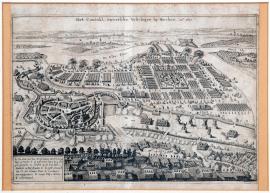
An illustration of the Swedish field camp at Werben, 1631.
The picture represents a large Swedish field camp at the confluence of the Elbe and Havel, not far from Werben, which was established by Gustav Adolf on the 12th of July 1631. The arrangement of tents and various other localities in the camp is interesting. In the background we can see the confluence of both of the mentioned rivers and the small fortified town of Werben. Tilly's troops are in the foreground. At the bottom on the left, there is a rectangle with the legend A-I.

An actual illustration of the royal Swedish field camp at Werben-on-Elbe. 1631. Werben and the Swedish camp.
This copperplate is identical to the print mentioned on the previous page under no. 133/238, which is labelled in Dutch, while sheet no. 134/262 is labelled with a German-Latin inscription.

Tangermünde.
The picture shows a view of the town of Tangermünde, which lies on the Elbe, approximately 100km west of Berlin, on a gentle hill. The Tanger river, flowing into the Elbe, is drawn on the print. In the sky there is a blank heraldic shield. In the foreground there is a fortified military camp on the bank of the Elbe. On the river, two ships are sailing.
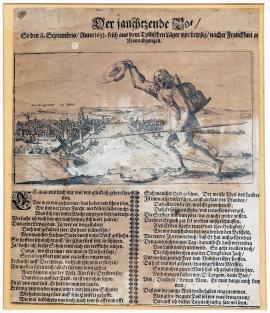
A rejoicing messenger, who on the morning of the 6th of September 1631 left Tilly's camp near Leipzig and (left) for Frankfurt-on-Mohan. Printed in 1632.
The print depicts general Tilly's messenger who is marching to Frankfurt-on-Mohan. He's holding a lance and waving a hat with the other; he has luggage tied to his back and an Imperial emblem with an eagle on his chest. The goal of his journey – Frankfurt-on-Mohan – is in the background. Beneath the illustrated scene there is a long German poem strongly describing daring and confidence in the victory of Tilly's army, which is preparing to fight against the troops of Gustav Adolf of Sweden and John George Elector of Saxony. The Elector of Saxony, in particular, is shown very frequently, as he only decided to fight on the Swedish side shortly before the Battle of Breitenfeld.
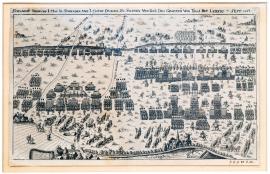
The position of the troops of His Majesty of Sweden the His Highness Elector of Saxony, and also Count Tilly, at Leipzig in 1631.
The picture has been drawn in a relatively primitive and simple way. It represents the position of both of the opponents' troops before the battle at Breitenfeld near Leipzig. The bottom of the picture shows a village with a church tower and a long ditch with a row of trees planted beside it; a little further on the left is another village. The destination at the end of the drawn paths is always labelled with an inscription. At the bottom on the right there is an orientation compass. In addition to the clamped military formations there are also many individual figures, horsemen, firing cannons, vehicles etc.
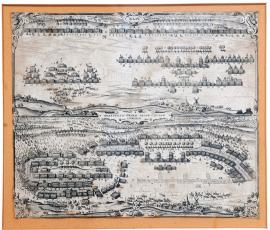
The positions (of the troops) in the battle which took place near Leipzig.
The copperplate is divided into two parts, of which the upper part depicts the positions of both of the opposing armies, the Imperial League and the Swedish-Saxon, between the Battle of Breitenfeld on the 17th of September 1631. At the bottom there is a picture of the battle in full swing; the Imperial-Bavarian divisions are in disarray and are retreating and fleeing. On both of the pictures, the village of Breitenfeld is at the bottom on the right. The whole copperplate is framed by a fine baroque frame with a small shield in the top centre, in which the number XLIV is written. The above-quoted Latin text is located on the decorative shield between both of the illustrated scenes.
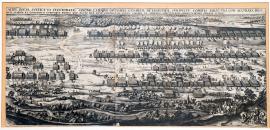
A picture of the positions of the Royal Swedish and Saxon Elector troops, and standing against them the Imperial and League troops under the command of Count Tilly, together with an accurate description of the positions of both sides' wings and divisions as they stood against each other before the clash at Leipzig, as is evident from this picture.
This is a fragment of a large copperplate, engraved á la Merian but unsigned. In the foreground of the military scene there is the village of Podelwitz, and an unnamed river. The left third of the picture shows the path to Wittenberg and Leipzig. Beside the path labelled with the letter “K“ is an illustration of general Tilly with his adjutant; on the right is King Gustav Adolf of Sweden with two horsemen. The above-quoted Latin text is located above the illustrated scene.
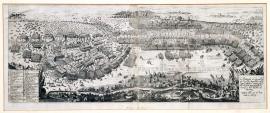
The Battle of Leipzig, which took place between the Imperial and Catholic League armies, and the armies of King Gustav Adolf of Sweden and the Elector of Saxony, on the 17th of September 1631.
The engraving represents a large prospectus of the Battle of Breitenfeld (of Leipzig). On the left-hand side the battle is already approaching its peak, but the situation on the right-hand side is not yet so advanced. In the foreground is a village with a windmill, a small church and groups of trees. In the foreground on the right there are several military emblems, and a little to the left there is an orientation compass. The quoted text is located in the rectangle at the bottom on the right; on the left there is another rectangle with the legend A-M.
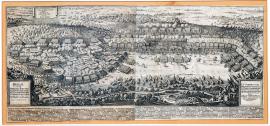
An illustration drawn in accordance with the exact positions of the troops in the battle between the Supreme King of Sweden and the Elector of Saxony, as well as the general of the Catholic League, Count Tilly, which took place on the 7th of September 1631 near Leipzig, also containing a statement of the losses and retreat of the Catholic troops, known to all the descendants, drawn by Oluv Hanson, surveyor of camps and architect, on the orders and under the supervision of the Supreme King.
This is a large and detailed picture of the Battle of Breitenfeld. The above-quoted text is located on the right. The entire area of the picture is filled with battle scenes with cannons, banners, cannonballs, kegs etc. An unnamed stream flows along the edge. The most intense battle rages on the left, beneath a hillock with a gallows across which many soldiers are fleeing. On the left at the top there is an incoiled vignette with battle slogans: “Gott mit uns“ (i.e. Swedish) and “Jesus Maria“ (i.e. Imperial). Under the picture are the legends A-X and 1-99.
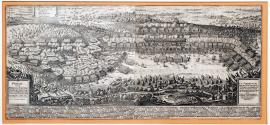
The Battle of Leipzig which took place between Imperial and Catholic League armies, and the armies of King Gustav Adolf of Sweden and the Elector of Saxony, on the 17th of September 1631.
The engraving represents a large prospectus of the Battle of Breitenfeld (of Leipzig). On the left-hand side the battle is already approaching its peak, but the situation on the right-hand side is not yet so advanced. In the foreground is a village with a windmill, a small church and groups of trees. In the foreground on the right there are several military emblems, and a little to the left there is an orientation compass. The quoted text is located in the rectangle at the bottom on the right; on the left there is another rectangle with the legend A-M.

An illustration of the city of Frankfurt-on-Mohan and how His Royal Highness of Sweden and his army entered the city and passed through it on the 17th of November 1631.
The picture shows the city of Frankfurt-on-Mohan. In the background there is a relatively high mountain range and in the foreground we can see Swedish troops, led by King Gustav Adolf, advancing on the city. On the right there are a number of trees and two trumpeters on horses, and in the top left-hand corner is the city emblem with a laurel branch around it. Below is the legend 1-22.
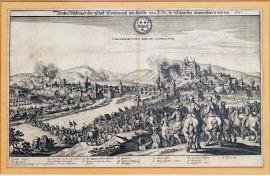
An actual illustration of the town of Kreuznach, which was conquered by His Highness of Sweden. 1631.
The print shows the town of Kreuznach, lying on the river Nahe (the right tributary of the Rhine), approximately 70 km south-west of Frankfurt-on-Mohan. The Swedish cavalry is fording this river. On the right, on a hillock, lies Kreuznach castle. The town extends over both banks of the Nahe, and is engulfed in flames. In the foreground, on the right, there are horsemen with banners. In the skies is the town emblem with the inscription: “Crucenacum a Svecis occulatur.“ (this should be “occupatur“). Below is the legend A-P. The distinctive drawing of horses' behinds, as we see them here, is quite typical of W. Hollar even though Drugulin states that the author is M. Merian; in 1631 Hollar was employed in the Merians' engraving workshop in Frankfurt and he usually did not sign the works he produced here.
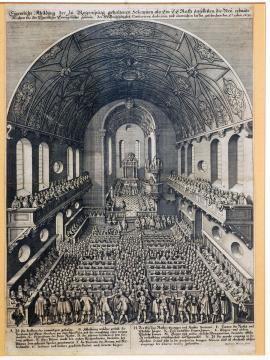
An unusual illustration of the festivities in Regensburg, held on the occasion of the council's consecration and ordination of the newly-built church of the Holy Trinity for the Christian Evangelical community, on the 5th of December 1631.
The engraving represents the interior of the large, vaulted cathedral with a presbytery, altar and pulpit. The cathedral is completely filled with people who are even crowding the oratories and the chancel. Above the picture is the quoted text, and below is the legend A-N.

An illustration of the town and the occasion on which His Highness King of Sweden and his army crossed the Rhine, forced the Spanish cavalry to flee, and conquered the town of Oppenheim on the 7th of December 1631.
The Rhine flows through the illustrated landscape, and the army of Gustav Adolf King of Sweden is advancing across it. In the foreground there are some small-scale military scenes with cavalry. On the other bank of the Rhine is the town of Oppenheim, already in the grip of sizeable Swedish forces. Above the picture is the above-quoted German text, and the legend A-V is below. The engraving is the work of Wenceslaus Hollar; it does not actually contain Hollar's signature but Urzidil states in his work on Hollar that it has been safely confirmed that the clash at Oppenheim was drawn by Hollar, who watched the course of the battle with his own eyes.


